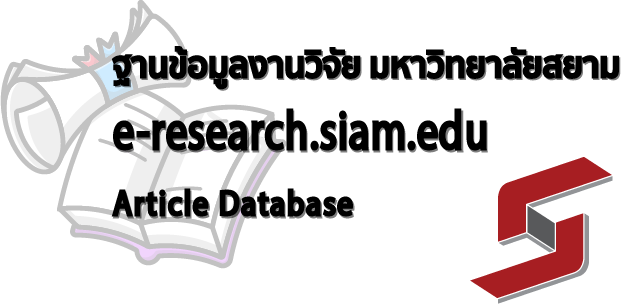- KB Home
- หลักสูตรปริญญาตรี|Bachelor Degree
- คณะแพทยศาสตร์
- Prevalence and Risk Factors of Work-Related Musculoskeletal Disorders in Central Sterile Supply Technicians, Nakhon Si Thammarat Province, Thailand
| Title: | Prevalence and Risk Factors of Work-Related Musculoskeletal Disorders in Central Sterile Supply Technicians, Nakhon Si Thammarat Province, Thailand |
| Researcher: | Withaya Chanchai, Ratree Nacglud, Keatkongkrai Bunnum, Nureeya Promsorn, Laddawan Duangmusik, Warunee Suwanrat, Wichuda Chantasin, Kritsana Thonnan |
| Degree: | Bachelor of Science Program in Occupational Health and Safety |
| Major: | B.Sc. (Occupational Health and Safety) |
| Faculty of study: | Department of Occupational Health and Safety, Faculty of Medicine |
| Academic year: | 2567 (2024) |
| Published: | Journal of Health Science and Medical Research, 20251146. https://doi.org/10.31584/jhsmr.20251146 Click |
Abstract
Objective: The study aimed to examine the prevalence of work-related musculoskeletal disorders among central sterile supply technicians (CSSTs) in Nakhon Si Thammarat Province, Thailand, and investigate the risk factors associated with these disorders.
Material and Methods: A cross-sectional study was conducted among CSSTs regarding work-related musculoskeletal disorders (WMSDs). Technicians were asked about the presence and severity of disorders throughout the whole body during the sterilization procedure. The survey was distributed to the CSSTs at the central sterilization supply departments (CSSDs) of 32 hospitals in Nakhon Si Thammarat province, Thailand.
Results: The prevalence rate of WMSDs in various bodily regions was assessed among technicians at the time of questioning (88.3%), after one week (65.4%), and after one year (59.2%). Various body parts were reported to have developed Musculoskeletal problems, with the lower back being the most frequently reported (88.8%), followed by the upper back (84.9%), and the ankles/feet (38.5%). These MSDs were influenced by age over 30 years (odds ratio [OR] 3.32, 95% confidence interval [CI] 1.59-6.93), work schedule (OR 2.58, 95% CI 1.02-4.96) and the handling of heavy-load equipment (OR 2.56, 95% CI 1.47-10.37) or carts, which significantly increased the risk of developing such illnesses.
Conclusion: Many CSSTs from the CSSDs reported WMSDs in various locations on their bodies. Lower back pain was the most common complaint.
Keywords: central sterile supply technicians, Musculoskeletal disorders; risk factors
ดร.วิทยา ชาญชัย – Dr. Withaya Chanchai. 2567 (2024). Prevalence and Risk Factors of Work-Related Musculoskeletal Disorders in Central Sterile Supply Technicians, Nakhon Si Thammarat Province, Thailand. บทความ (Paper). วิทยาศาสตร์สุขภาพ|Health Science. แพทยศาสตร์ ภาควิชาสาธารณสุขศาสตร์ (Medicine, Department of Public Health Science). วิทยาศาสตรบัณฑิต สาขาวิชาอาชีวอนามัยและความปลอดภัย – Bachelor of Science Program in Occupational Health and Safety. วท.บ. (สาขาวิชาอาชีวอนามัยและความปลอดภัย) – B.Sc. (Occupational Health and Safety). Bangkok: Siam University


